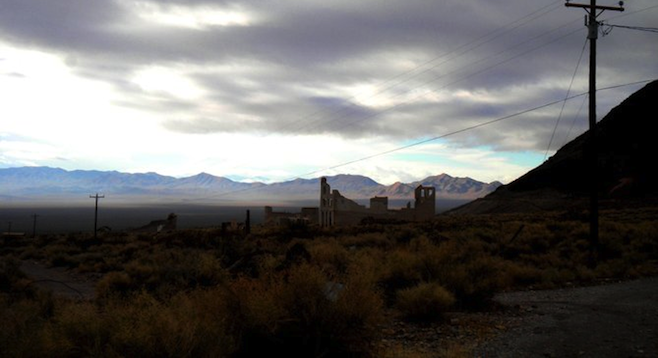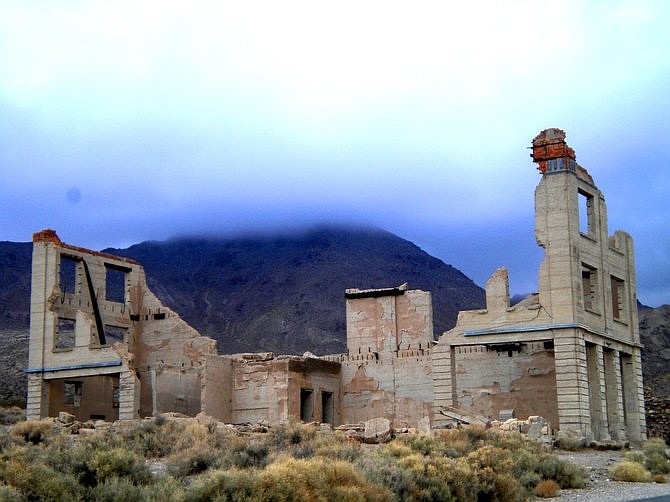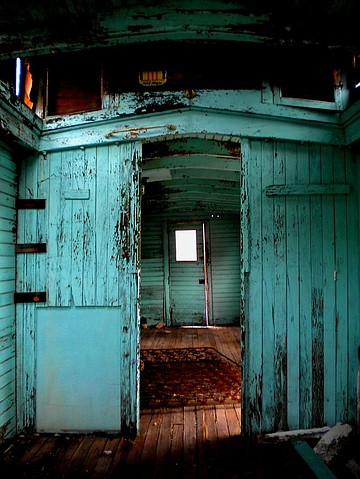 Facebook
Facebook
 X
X
 Instagram
Instagram
 TikTok
TikTok
 Youtube
Youtube

Rolling into the small town of Beatty, Nevada, is a strange experience.
One of the few settlements on the edge of the brutal Death Valley, it appears as a welcome rise of gaudy lights after so many miles of inhospitable nothing. Yet it is far from a glamorous destination – don’t get me wrong, if you like overpriced motels and more brothels than gas stations, then Beatty will be a blast. For the rest of us… it’s a convenient place to catch a burger and a few hours' sleep before diving back into the desert.
I shouldn’t be too harsh on Beatty. It's worth a visit alone for the spectacular ghost town that sits on its doorstep (and the largest candy and nut store in Nevada, apparently). Armed with plentiful supplies of trail mix, we headed into Rhyolite.
Rhyolite is one of the best-preserved ghost towns I've found in the Southwest. On the eastern outskirts of Death Valley, it must have been a hive of excitement during the lucrative Gold Rush days. But the San Francisco earthquake of 1906 and following financial crisis devastated its economic prospects and led to the mine’s closure in 1910. Since then, the town has packed up, shipped out and slowly faded from glory to the tourist-friendly remains that stand there today.
Despite decades of battery from winds and wastes, the town still stands – and although some of the surrounding wooden houses are on the brink of collapse, their ramshackle appearance only adds to the town’s photogenic charm. The more resilient buildings are roped off to protect their history from curious idiots (and to protect curious idiots from broken ankles and tetanus punctures), but these restrictions don’t deter from the experience.

On the morning of our visit (en route to find the mythical Barker Ranch and Charlie Manson’s truck on the other side of Death Valley), Rhyolite was mysteriously empty. The skeletal remnants of the three-story Cook Bank rose up against the misty Sawtooth and Bullfrog Mountains (left). A scattering of crows were the only signs of life intruding on our explorations.
The impressive casino, now preserved in a state of permanent decay, started life as a train depot built to accommodate the tons of ore being shipped out for profit. At the height of its success, three railroads served Rhyolite. It's easy to imagine those same carriages only a few years later, laden down with deserters looking for luck elsewhere.

The blistering desert heat has since weathered the static wooden caboose into beautiful red and turquoise tones – a real gem for the camera lens, and a testament to the abandoned lives and dreams of those who lived here.
On a visit, it is worth stopping by the curious Bottle House built from 50,000 liquor bottles, whose walls dazzle green and brown hues when the sun is overhead. And for fans of vehicular history, there are classic cars and old trucks dotted around town, rusting gloriously. Try not to be put off by the "No Shooting" signs riddled with bullet holes; you’re on federal-protected land and at far more risk from rattlesnakes, probably.
A scrabbling climb up a low bank brings you to the mouth of the mine (top). It is (wisely) locked off, but it does give a spectacular view of the town and mountains beyond. With more time we would have embarked on one of the recommended hikes through the mountains, but there were more miles of desert to rack up and other ghost towns to find.
From our crow’s-eye vantage spot, Rhyolite was an eerie little place, made even weirder by the offbeat sculpture gallery rising up from the sandy flats at the town’s entrance. The modern colors and shapes stand in surreal conflict to the slow-burning disintegration of the original settlement, and the creepy "The Last Supper" - a sculpture by Albert Szukalski comprising twelve sinister robed ghosts - is especially uneasy viewing, even on a quiet sunny day.
On the dusty drive out of town, leave enough time to stop at the cemetery for a contemplative stroll through the ancient wooden grave markers, before rejoining Route 374 and plunging back into California’s most arduous national park.
And make sure you fill up on gas at Beatty; it’s a long drive back to populated civilization.


Rolling into the small town of Beatty, Nevada, is a strange experience.
One of the few settlements on the edge of the brutal Death Valley, it appears as a welcome rise of gaudy lights after so many miles of inhospitable nothing. Yet it is far from a glamorous destination – don’t get me wrong, if you like overpriced motels and more brothels than gas stations, then Beatty will be a blast. For the rest of us… it’s a convenient place to catch a burger and a few hours' sleep before diving back into the desert.
I shouldn’t be too harsh on Beatty. It's worth a visit alone for the spectacular ghost town that sits on its doorstep (and the largest candy and nut store in Nevada, apparently). Armed with plentiful supplies of trail mix, we headed into Rhyolite.
Rhyolite is one of the best-preserved ghost towns I've found in the Southwest. On the eastern outskirts of Death Valley, it must have been a hive of excitement during the lucrative Gold Rush days. But the San Francisco earthquake of 1906 and following financial crisis devastated its economic prospects and led to the mine’s closure in 1910. Since then, the town has packed up, shipped out and slowly faded from glory to the tourist-friendly remains that stand there today.
Despite decades of battery from winds and wastes, the town still stands – and although some of the surrounding wooden houses are on the brink of collapse, their ramshackle appearance only adds to the town’s photogenic charm. The more resilient buildings are roped off to protect their history from curious idiots (and to protect curious idiots from broken ankles and tetanus punctures), but these restrictions don’t deter from the experience.

On the morning of our visit (en route to find the mythical Barker Ranch and Charlie Manson’s truck on the other side of Death Valley), Rhyolite was mysteriously empty. The skeletal remnants of the three-story Cook Bank rose up against the misty Sawtooth and Bullfrog Mountains (left). A scattering of crows were the only signs of life intruding on our explorations.
The impressive casino, now preserved in a state of permanent decay, started life as a train depot built to accommodate the tons of ore being shipped out for profit. At the height of its success, three railroads served Rhyolite. It's easy to imagine those same carriages only a few years later, laden down with deserters looking for luck elsewhere.

The blistering desert heat has since weathered the static wooden caboose into beautiful red and turquoise tones – a real gem for the camera lens, and a testament to the abandoned lives and dreams of those who lived here.
On a visit, it is worth stopping by the curious Bottle House built from 50,000 liquor bottles, whose walls dazzle green and brown hues when the sun is overhead. And for fans of vehicular history, there are classic cars and old trucks dotted around town, rusting gloriously. Try not to be put off by the "No Shooting" signs riddled with bullet holes; you’re on federal-protected land and at far more risk from rattlesnakes, probably.
A scrabbling climb up a low bank brings you to the mouth of the mine (top). It is (wisely) locked off, but it does give a spectacular view of the town and mountains beyond. With more time we would have embarked on one of the recommended hikes through the mountains, but there were more miles of desert to rack up and other ghost towns to find.
From our crow’s-eye vantage spot, Rhyolite was an eerie little place, made even weirder by the offbeat sculpture gallery rising up from the sandy flats at the town’s entrance. The modern colors and shapes stand in surreal conflict to the slow-burning disintegration of the original settlement, and the creepy "The Last Supper" - a sculpture by Albert Szukalski comprising twelve sinister robed ghosts - is especially uneasy viewing, even on a quiet sunny day.
On the dusty drive out of town, leave enough time to stop at the cemetery for a contemplative stroll through the ancient wooden grave markers, before rejoining Route 374 and plunging back into California’s most arduous national park.
And make sure you fill up on gas at Beatty; it’s a long drive back to populated civilization.
Comments